The Ovary in Botany
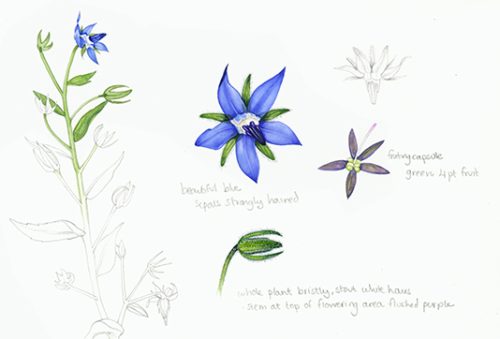
Botanical illustrators have to understand the terminology that applies to their subject matter. This includes knowing about the ovary. All of my illustrations for this blog are taken from The Garden Forager by Adele Nozedar. (See more on my Pinterest site.)
Re-cap of the basic botany of flowers
Following on from my blog about Botany terms; this week I’m going to explore the ovary. Knowing about a plant’s ovary helps you know what flower you’re illustrating. First, let’s have a recap of basic botany.
The flower’s ovary contains unfertilized seeds, (ovules). Protruding from this is a tube called a style, with an area at the tip called the stigma. This is where pollen hopes to land and burrow down to fertilize the ovules. The result is seeds.
Working out from the centre of a flower, there are rings of flower parts. We have the female reproductive parts. Then there’s the male reproductive parts. Petals and sepals appear next; but these aren’t involved in plant sexual reproduction.
Position of the Ovary
Let’s look at the position of the ovary. So here’s a diagram (modified from Swink and Wilhelm, Plants of the Chicago region).
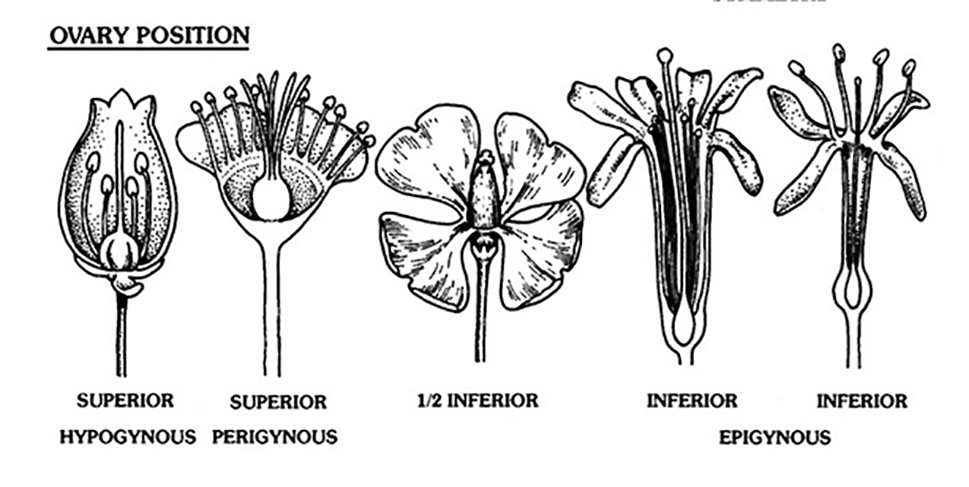
On first sight it looks complicated, but actually this is one bit of botanical terminology that’s really straight forward.
Is the ovary above or below the flower parts?
Plants can be classified depending on where their ovary sits. And they all relate to the receptacle. Receptacles are the bit to which the flower parts are attached. First you can have a superior ovary. Here, the ovary attaches to the receptacle ABOVE the rest of the flower. Second, you have an inferior ovary. This means the ovary attaches to the receptacle BELOW the other parts of the flower. Finally, there’s a middle one, the half-inferior ovary. So this is where the other parts of the flower attach to the ovary on the SAME LEVEL as the receptacle.
The Superior ovary
Examples of plants with a superior ovary include mallow (Malva sylvestris). Look closely at my longditudinal cross section and you can see the ovary sits below the petals.
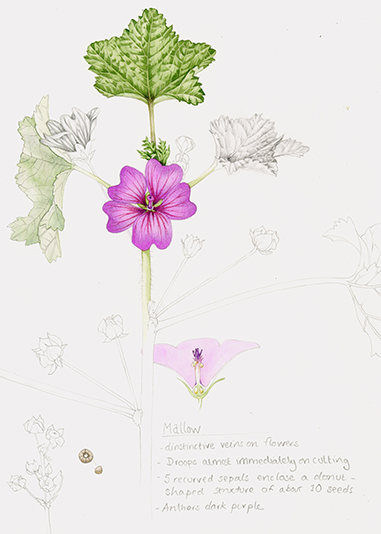
Another plant with a superior ovary is borage (Borago officinalis). You can see how the rest of the flower parts grows below the developing seeds.
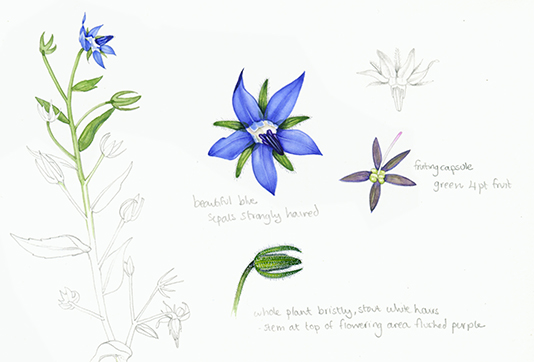
Other plants sporting superior ovaries include buttercups, grapes, geranium, and tomato. In fact, all plants which produce true berries and drupes fall into this category (see my blog on Fruit type terminology).
What does Hypogynous mean?
All these plants with superior ovaries are said to have hypogynous flowers. This just means they have superior ovaries. Let’s continue.
The half-inferior ovary
Next up is the half-inferior ovary. The flower parts here are surrounded by the receptacle, or embedded in it. The first example is the rose (Rosa).

Have a close look. The stamens, petals and sepals are all pretty much on the same level as they attach to the green receptacle. When the rose develops a rosehip you can see the flower remnants aren’t at the very tip, but a bit lower down. A half-inferior ovary.
Another example is the passion flower (Passiflora).
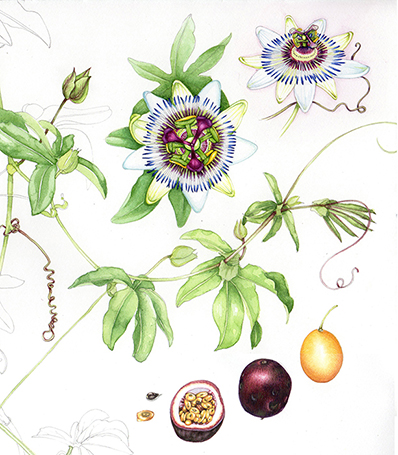
Passion flowers are mad to draw. However, with all the flower parts so large it’s clear that their insertion points aren’t above or below the receptacle, but on the same plane. A half-inferior ovary. Other examples are Pyracanthus and some of the Lythraceae family.
What does Perigynous mean?
Plants with half-inferior ovaries are referred to as perigynous flowers.
The Inferior Ovary
Last up are plants with inferior ovaries; where the ovary sits neatly below the point of attachment for the other parts of the flower. An example of this is the fucshia (Fucshia spc).

In this illustration, look at the cross-section. You can see that the ovary lies below the rest of the flower. In fact, you can see it in the colour study; the darker region below the petals encloses the ovary.
Other examples include the orchid family, and some members of the Asteraceae family ( click for more on Composite flowers). Each individual disk and ray floret has an ovary at its base. In this case these are inferior ovaries. These mature into seeds known as cypselas (an achene, for more on achenes read my blog). Just think of a dandelion seed. All the fluff at the top, then the seed very firmly below the rest of it. An inferior ovary.
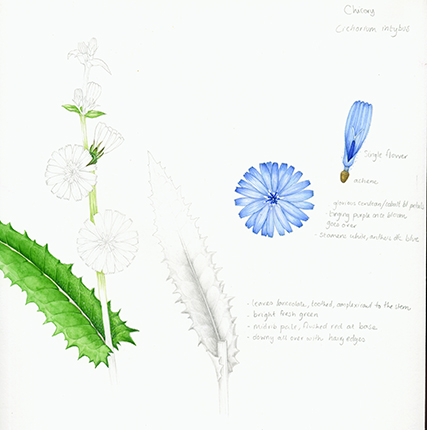
This chicory flower shows the blue petals (corolla) and stamens above the brown receptacle which encloses the ovary below.
What does Eipgynous mean?
Plants with inferior ovaries are said to bear epigynous flowers, or to be eipgynous.
To be honest, at first when I researched this topic my blood ran cold as the latin terms washed round my brain; but actually I hope I’ve shown that ovary position and the latin terms used to describe this are quite straight forward. My botany bible for definitions is Flora of the British Isles by Clapham, Tutin, and Moore. However, I do want to point out that I’m an illustrator not a botanist, so if you find mistakes in these botany blogs, please get in touch and let me know so I can fix them.


Please where does pride of Barbados flower fall under
Hello Fisch
The Pride of Barbados flower, Caesalpinia pulcherrima, is in the pea or Fabaceae family. These pea flowers have an elongated superior ovary (you can sometimes see the remains of petals at the base of the seed pods). The style tends to be curved and there are mostly 10 stamens. Hope this helps? Thanks for the question (fingers crossed I got the answer right!)
Yours
Lizzie
This was a very insightful and educational post, great job Lizzie, well impressed and has helped me massively!
Hi Dominic
That is such a great comment, I am so pleased. Ill be honest, writing this blog did my head in! So often with botany it’s like a double translation – you have to figure out what all the different terms for the the same things actually MEAN first…and then you have to try and translate them into english. It was the inferior/superior bit that really confused me til I untangled it.
So glad to be of use, and thanks for taking the time to leave a comment!
Yours
Lizzie
Wow, this is a fascinating post about the ovary in botany! Understanding the terminology related to botanical subjects is crucial for botanical illustrators, and the ovary plays a significant role in identifying and illustrating different flowers. It’s interesting to learn about the basic botany of flowers, especially the ovary’s function in producing unfertilized seeds (ovules), and how pollen interacts with the stigma to fertilize them. The diagram you shared provides a clear visualization of the ovary’s position within the flower. Thanks for sharing this valuable information!
Hi Addison
My absolute pleasure. I write these blogs after needing to research a topic for work, so they act like reminders for me too. Really glad you found the blog helpful.
X